Boots on the Ground
First published in Sanctuary Asia,
Vol. 40
No. 12,
December 2020
A Sanctuary Report
As governments fumble and international treaties fail to adequately confront the climate and extinction crises, an aura of despair prevails. With many of the rich and powerful being found complicit in environmental crimes, Cara Tejpal turn for inspiration to India’s grassroots conservation practitioners.
The Summer of Our Discontent
In November 2020, the raging Baghjan fire at Oil India Limited’s well number five was doused by a snubbing unit from Canada after 159 days. Declared India’s “longest burning gas blaze” by the BBC, it had destroyed the homes, lives and livelihoods of the neighbouring rural community, devastated the precious Maguri beel (wetland), and claimed at least three human and uncountable non-human lives. The same month, a committee appointed by the National Green Tribunal found that the Baghjan oilfield was operating without mandatory environmental clearances, and recommended legal action against Oil India Ltd., a public sector company.
The year 2020 has been a reckoning of sorts. For the first time in India’s recent history, the scale of environmental atrocities has permeated popular discourse. Imprisoned within their homes by the rampaging COVID-19 virus, itself a result of our fractured relationship with the rest of the natural world, Indians from every walk of life have taken umbrage to the dismal state of environmental governance. Perhaps nothing illustrates this better than the response to the government’s proposed Draft Environmental Impact Assessment Notification, 2020. The widely panned draft prompted a staggering 1.7 million submissions from the public, mostly objections to the dilution of crucial environmental safeguards.
But even as campaigns have mushroomed across the country, campaign victories have been few and far apart. The global scenario has been just as bleak, with international governments failing to meet a single one of the 20 Aichi targets to halt biodiversity destruction between 2010 and 2020; and signatories to the Paris Agreement floundering to meet their Nationally Determined Contributions on climate action. “It is the money and profit motive that is ruling our actions, unfortunately, and not the environment… Countries are pledging but are not delivering – there is an accountability gap,” asserted Dr. Jyotsna Puri of the Independent Evaluation Office of the Green Climate Fund as she took the floor during the Sanctuary Global Debate 2020. It was a point impossible to counter.
Ekla Chalo Re
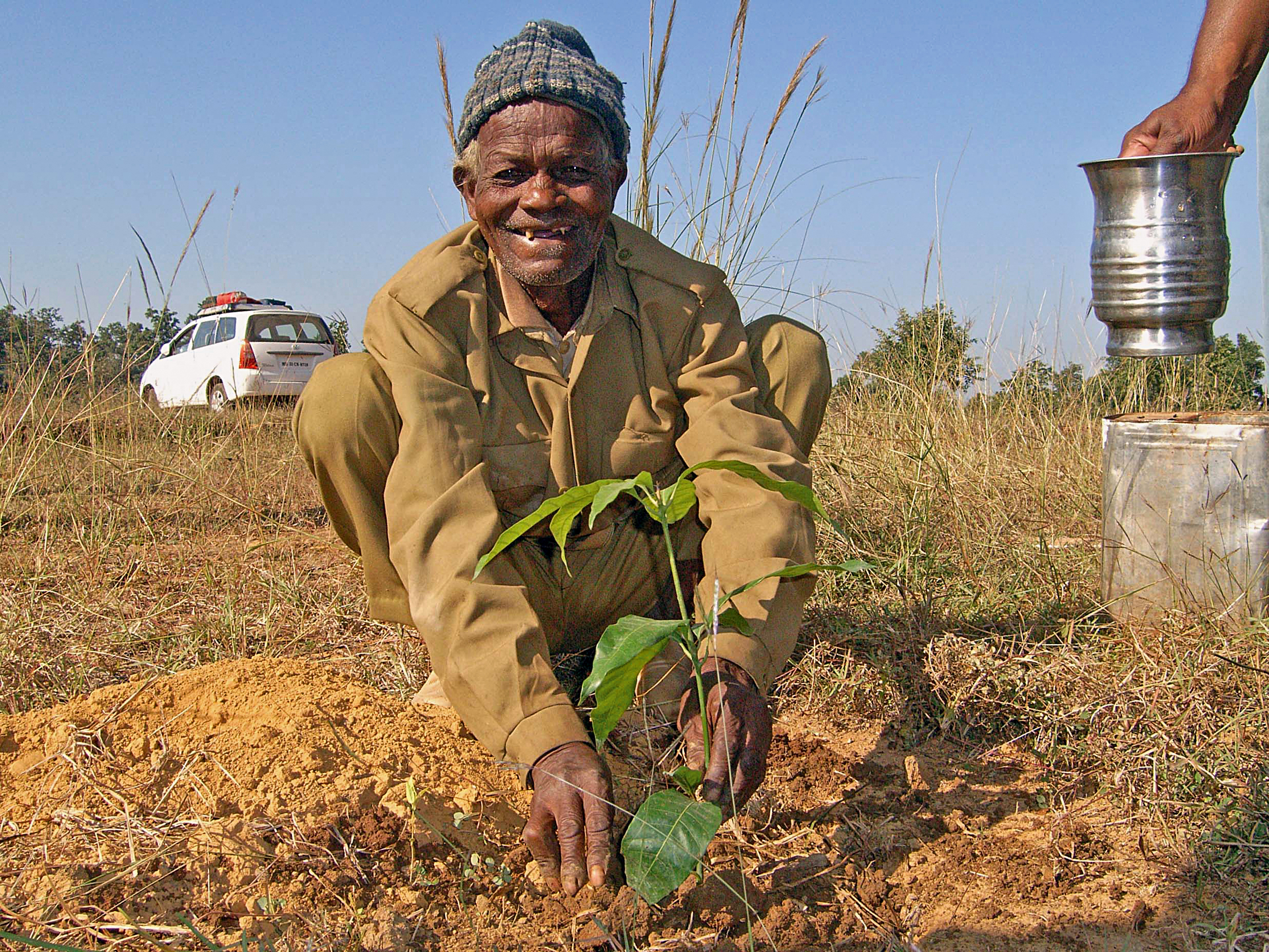
The late Manglu Baiga was a wildlife tracker employed by the Madhya Pradesh Forest Department. He was an astoundingly knowledgeable and talented naturalist who influenced innumerable researchers and forest officials. Photo: Dr. C.J. Meadows
A wrinkled face beams out from the folds of an old issue of Sanctuary Asia magazine. A wizened old man – missing his front teeth, clad in the signature olive of India’s forest guards – plants a sapling. This is the obituary of Manglu Baiga, a formally unschooled Baiga tribesman who spent decades protecting the Kanha Tiger Reserve. Manglu and myriad other grassroots conservation workers have long influenced Sanctuary’s compass and editorial content, bringing jargon-free realities and ingenious solutions from the frontlines to our readers.
Though conservation discourse is dominated by bureaucrats and scientists, it is implemented on the ground by individuals who rarely find themselves on high-powered committees and government boards. Yet, time and again, when governments and academicians have been unable to provide succour, grassroots conservation practitioners have displayed resilience and granted us hope.
Thumbing through old issues of Sanctuary one finds names such as Qasim Wani and Abdul Rahman Mir, one now gone and one retired, who nurtured the glorious slopes of Dachigam in Kashmir; E.A. Kuttappan, who led the mahouts of Bandhavgarh on elephant patrols that saved the lives of countless tigers; Bholu Abrar Khan, who assisted, nay, collaborated with the great Dr. Sálim Ali to make Bharatpur the birders’ pilgrimage that it is today; Haseena and Tajunissa, young Muslim women from the Lakshadweep archipelago who built the bridge between local communities and the Bombay Natural History Society; Biba Sonowal, Pallabita Bora, Swarnalata Bhuyan, and Anita Das, Kaziranga’s very first all women patrol team; Arthi Venkatesham and Bhumani Venkatesham, members of the Chenchu tribe eternally committed to the preservation of the Nagarjunasagar Srisalam Tiger Reserve; Maheshwar Basumatary, who gently nursed orphaned rhino calves in Assam so that they may be released back into the wild; and Jadav Payeng, who quietly grew a forest even before the term “nature-based solutions” and “rewilding” became part of conservation lexicon.

Mahilabai Pardhi has been instrumental in bringing education to her unfairly maligned Pardhi community in Madhya Pradesh. Photo courtesy: Kaustav Patel.
The Mud On Boots Project 2021–2022
In 2017, Sanctuary made the transition from a mere publication (albeit with a reputation for activism) to a not-for-profit foundation – the Sanctuary Nature Foundation (SNF). At this time, the need to codify the commitment to on-ground conservation became urgent. Thus was born the Mud on Boots Project. Taking root as a small grants initiative instituted in memory of wildlife lover and philanthropist Tina Abraham, the Mud on Boots Project has evolved into a robust booster programme designed to empower grassroots conservation leaders across India. An inherently flexible project, it provides a monetary grant and customised support to community leaders over a two-year period. These Project Leaders are identified by SNF’s formidable network of wildlife professionals. Eschewing much, though tragically not all, the cumbersome paperwork and bureaucracy of more clinical programmes, the Mud on Boots Project is a deeply collaborative and trust-based endeavour.
As 2020 draws to a close, SNF is elated to introduce readers to the Mud on Boots Project Leaders for 2021–2022.
PHUNTSOG DOLMA
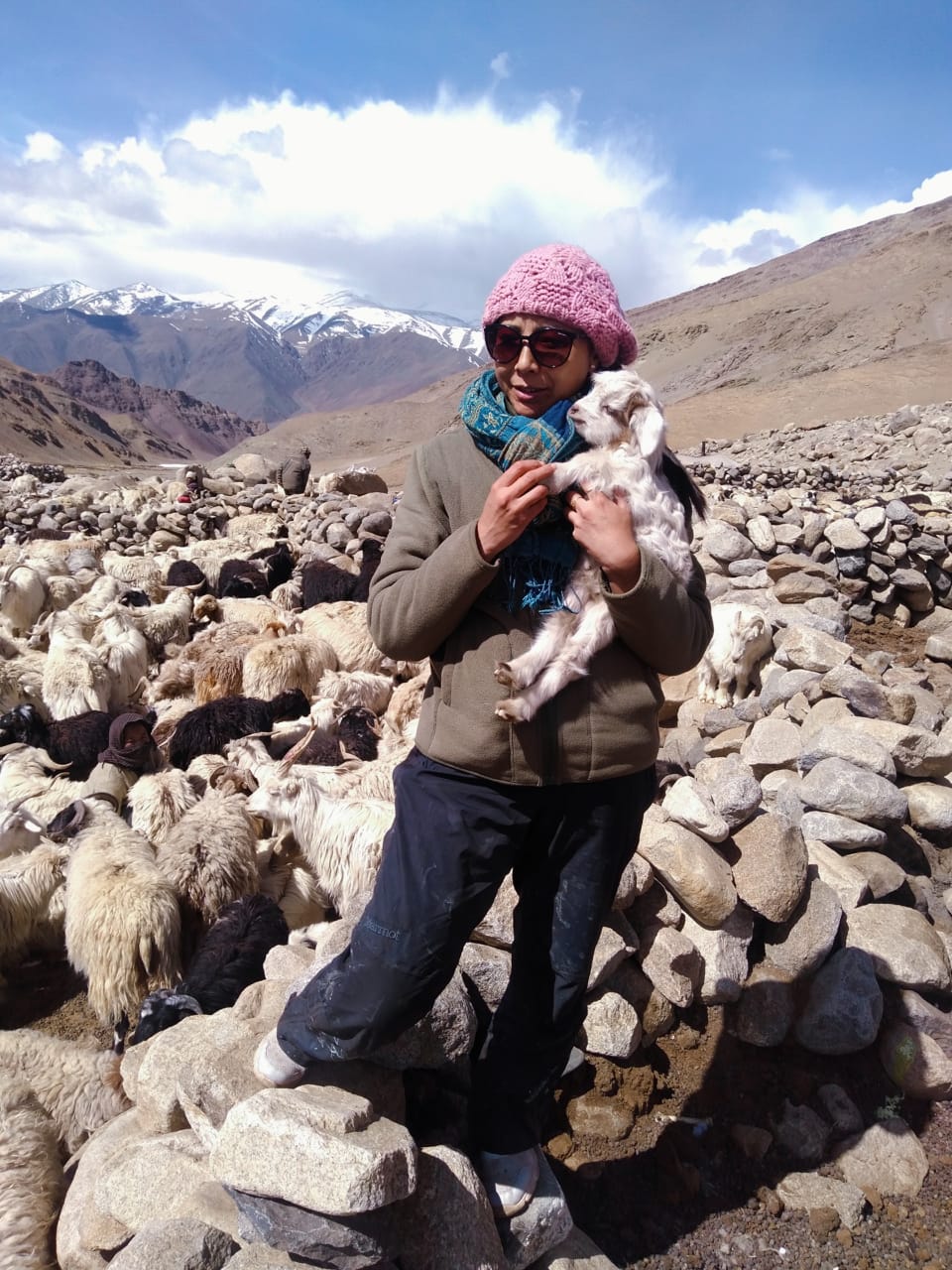 Photo courtesy: Munib Khanyari
Location:
Photo courtesy: Munib Khanyari
Location: Nimmo village, Leh district, Ladakh
Occupation: Flock Supervisor, District Sheep Husbandry Department
Nominated by: Munib Khanyari, Nature Conservation Foundation-India
A young woman working with the sheep husbandry department in Ladakh, Phuntsog ensures that livestock health is maintained across the Rong region. Her work secures people’s livelihoods and prevents diseases from spilling over to the unique wildlife of the area. Phuntsog has a personal interest in the plant diversity of this landscape and is exploring the uses and conservation of various floral species (see page 36). She is the co-author of a soon to be published book titled The Plants of Ladakh – A Photographic Guide.
Plant research and conservation in Ladakh has seen a severe paucity. Phuntsog isn’t only building a knowledge baseline for plants, but also working with local stakeholders to understand the richness and pressures on pastures so as to ensure human-wildlife coexistence. This is critical in this predominantly pastoral society. Through her efforts, Phuntsog is bridging the knowledge gap and the communication gap, as her book has information in Ladakhi and English.
With support from SNF and guidance from scientists from Nature Conservation Foundation-India, Phuntsog will be able to expand her work to include further surveys and studies on plant diversity and threats to pasture lands; understand the link between livestock grazing, wild herbivore grazing and plant diversity; conduct awareness programmes on the importance of native plants for local residents and nomads; and eventually create a database of high-altitude plants found in the area.
DECHIN PEMA SAINGMO & PEMBA ROMO
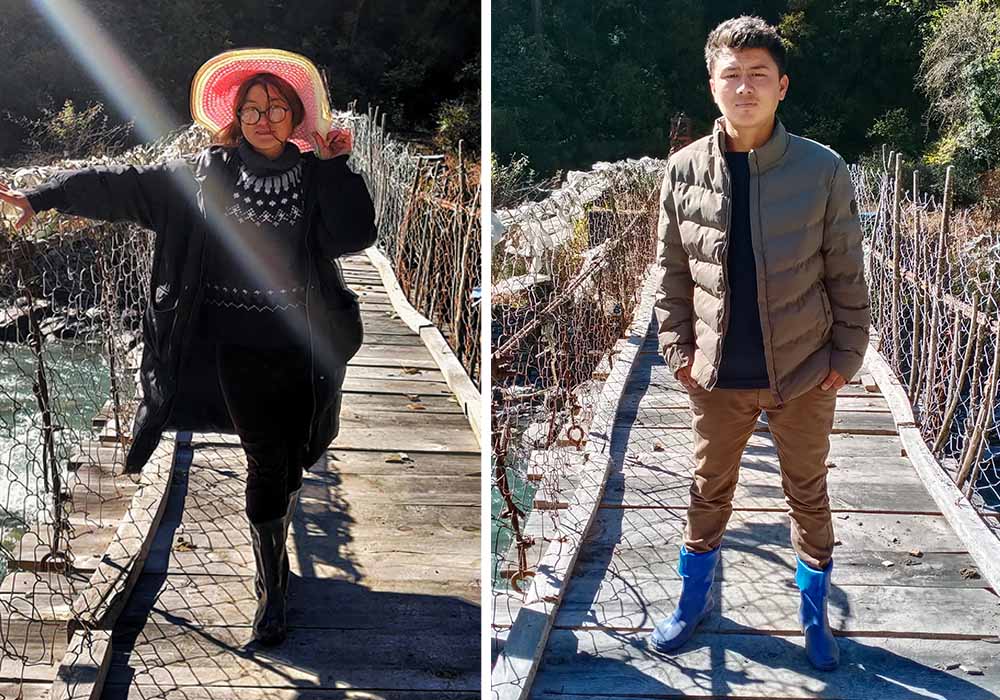 Photo courtesy: Janaki M.
Location:
Photo courtesy: Janaki M.
Location: Mago-chu Valley, West Kameng and Tawang districts, Arunachal Pradesh
Occupation: Project Assistants, WWF-India
Nominated by: Janaki M., WWF-India
Dechin (left) and Pemba (right) have been working as Project Assistants under the guidance of Janaki M., a Project Officer of WWF-India’s Western Arunachal Landscape. Over the past three years, they have been actively involved in camera trapping across various study sites as well as engaging in community outreach. Both research assistants are also alumni of Green Hub, a video documentation centre in Tezpur, Assam.
The duo seek to engage with eight village communities in the Mago-chu Valley to understand and document their perception of conservation, traditional practices and institutions that are rooted in natural resource management. They will also actively work with the community to learn more about the threats and challenges they face, in a natural resource context, and discuss possible solutions for the same. This will greatly contribute to tailoring conservation action and building strong relationships with the communities. Alongside this intensive community outreach work, both Dechin and Pemba intend to use their photo and video documentation skills to record the flora and fauna of the valley.
Support from SNF will allow Dechin and Pemba to raise their profiles, deepen their work, grow their network, and be recognised as active stewards of community-based conservation in India.
AMIR KUMAR CHHETRI
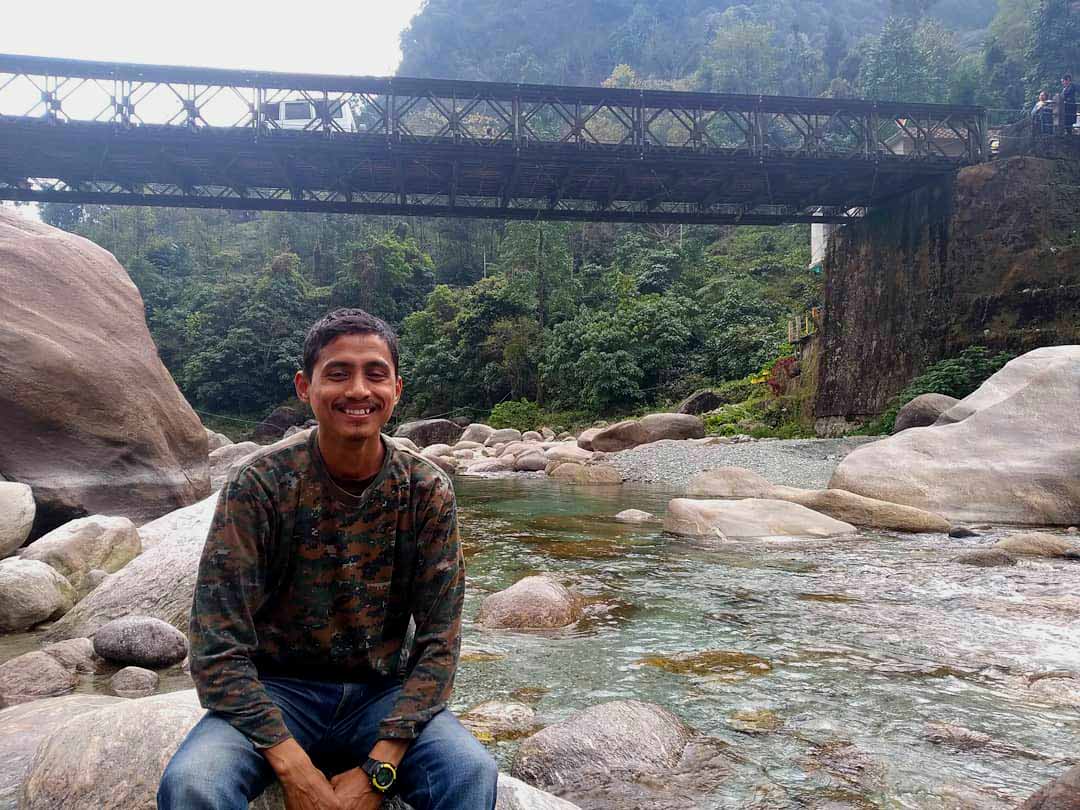 Photo courtesy: Priyanka Das
Location:
Photo courtesy: Priyanka Das
Location: Panijhora village, Jalpaiguri district, West Bengal
Occupation: Research Assistant and Safari Guide
Nominated by: Priyanka Das, The Coexistence Project
Born and brought up in a remote forest village, Amir Chhetri’s indigenous knowledge and skills are admired by his colleagues at The Coexistence Project. From a young age, Amir has worked with the Forest Department on fire management and anti-poaching drives, and as a safari guide for visiting tourists. Over the years, he has also worked with a range of researchers from reputed organisations and has developed skills in camera trapping, mist netting and conducting interviews.
Amir currently works as a Project Assistant with The Coexistence Project, which aims to foster safer shared spaces between people and wildlife in West Bengal, using science-based conservation interventions. Amir seeks to mitigate conflict between humans and wild elephants in the small forest village of Panijhora, adjacent to the Chapramari Wildlife Sanctuary and the territorial forests of Jalpaiguri Forest Division. Its residents practice sustenance farming but face heavy crop depredation from elephants and other wild animals. They currently use loud noises and bright lights to deter wildlife from entering their fields. The community is exceedingly tolerant of wild animals, and the village has not reported a single human or animal casualty despite the conflict. With the grant from SNF, Amir aims to build a fence around the crop fields of his village, which will be owned and maintained by the village community. This will serve as a pilot project to explore the efficacy of community-owned fences in conflict areas, and can be implemented at a larger scale after incorporating learnings.
VISHAL AHUJA
_1606972674.JPG) Photo courtesy: Vishal Ahuja
Location:
Photo courtesy: Vishal Ahuja
Location: Chamba Valley, Chamba district, Himachal Pradesh
Occupation: Project Assistant, Wildlife Information Liaison Development Society
Nomianted by: Payal B. Molur, Wildlife Educator
A resident of Chamba Valley, Vishal was hired by the Himalayan Grey Langur Project when it received the Conservation Leadership Award in 2012, and receives limited support from Wildlife Information Liaison Development Society. For the past eight years, he has been documenting the wild dietary preferences of the Himalayan grey langur, rhesus macaque and Himalayan black bear in the fragmented landscape around Khajjiar-Kalatop Wildlife Sanctuary. He has observed that the lack of adequate habitat has resulted in increased human-wildlife interactions, such as crop-raiding of agricultural fields and accidental attacks by bears.
With support from SNF, Vishal seeks to initiate a long-term habitat restoration project that will include setting up a native plant nursery, collecting and germinating wild native plants, and rewilding abandoned terraced farmlands with the consent and support of the landowners. Dedicated, passionate and diligent, Vishal is a wonderful community liaison. He believes his project will ultimately provide food and habitat to wild species, while reducing crop depredation. Vishal’s work will be guided by Dr. Sanjay Molur, Executive Director, Zoo Outreach Organisation.
RADHESHYAM PEMANI BISHNOI
_1606973131.jpeg) Photo courtesy: Sumit Dookia.
Location:
Photo courtesy: Sumit Dookia.
Location: Pokhran, Jaisalmer district, Rajasthan
Occupation: Volunteer, ERDS Foundation
Nominated by: Sumit Dookia, ERDS Foundation
Twenty-year-old Radheshyam Bishnoi is a local volunteer with Dr. Sumit Dookia’s Ecology, Rural Development and Sustainability Foundation that focuses on community conservation of the critically endangered Great Indian Bustard (GIB) in Rajasthan. Radheshyam belongs to the Bishnoi community, which is famous for its reverence for nature.
The Pokhran area of Jaisalmer is home to around 30 GIBs, which roam outside of designated Protected Areas and thus often escape the purview of the Forest Department. Radheshyam monitors the GIBs in this landscape, conducts anti-poaching initiatives, and helps with wildlife rescues. Most importantly, he coordinates a network of village volunteers with the aim to develop a GIB-friendly community.
Radheshyam has been instrumental to conservation efforts in the area, recently providing information that led to the arrest of a poaching gang in April. He has also consistently highlighted the threat to GIBs from overhead high-tension power lines, recently discovering and reporting four dead GIBs under such wires to the Forest Department.
Radheshyam wishes to pursue conservation fulltime. Over the past three years, he has evolved from an animal welfare worker concerned with chinkara rescue to a grassroots wildlife conservationist who takes a landscape level approach. With SNF’s support, he will continue to grow the GIB Community Conservation Project in the Thar Desert under the mentorship of Dr. Dookia.
Building A Bridge Between Biodiversity Conservation, Human Rights & Our Wild World
Sanctuary acknowledges the fraught historical relationship between the proponents of wildlife conservation and tribal/indigenous rights activists, borne in large part as a result of exclusionary policies, miscommunications, erosion of traditional practices, misdirected development policies, and poor implementation of laws. This decades-old rift has only diluted both causes, and must be patched in the interest of climate action, social justice, and ecological security for all.
Sanctuary is a signatory to the Global Charter for Rewilding the Earth, which states: “the significant alignment of biodiversity-rich habitats and indigenous territories presents the opportunity to simultaneously support traditional land tenure, gain wisdom from the knowledge and practices of indigenous communities, respond to climate change, and sustain biodiversity beyond Protected Areas.”
We, at Sanctuary, recognise that biodiversity conservation is not possible without respect for, and support and stewardship of indigenous and local communities. We are committed to giving a platform to such voices, and nurturing an ever-evolving ethic that reflects equitable and just practices.
The Event that Wasn’t
In January 2020, the SNF team was neck-deep in preparations for the 11th World Wilderness Congress, scheduled to take place in Jaipur in March. By the end of February, WILD11 stood cancelled as the COVID-19 pandemic tightened its stranglehold on India.
Amongst the plethora of events and venues at the Congress was a dedicated platform for grassroots and indigenous nature protectors. The Sanctuary team spent months curating and organising these “storytelling sessions” that tragically never came to be.
Here, we give Sanctuary readers a glim pse at this cancelled schedule, and invite event organisers from across the world to consider giving a platform to any or all of these speakers and add depth to our collective dialogue on conservation:
The Bard of Dachigam
Forester Nazir Malik has spent his life defending Kashmir’s breathtaking Dachigam
National Park. Through poetry and music, he introduces us to this sublime wilderness.
Language: Hindi/Urdu & English
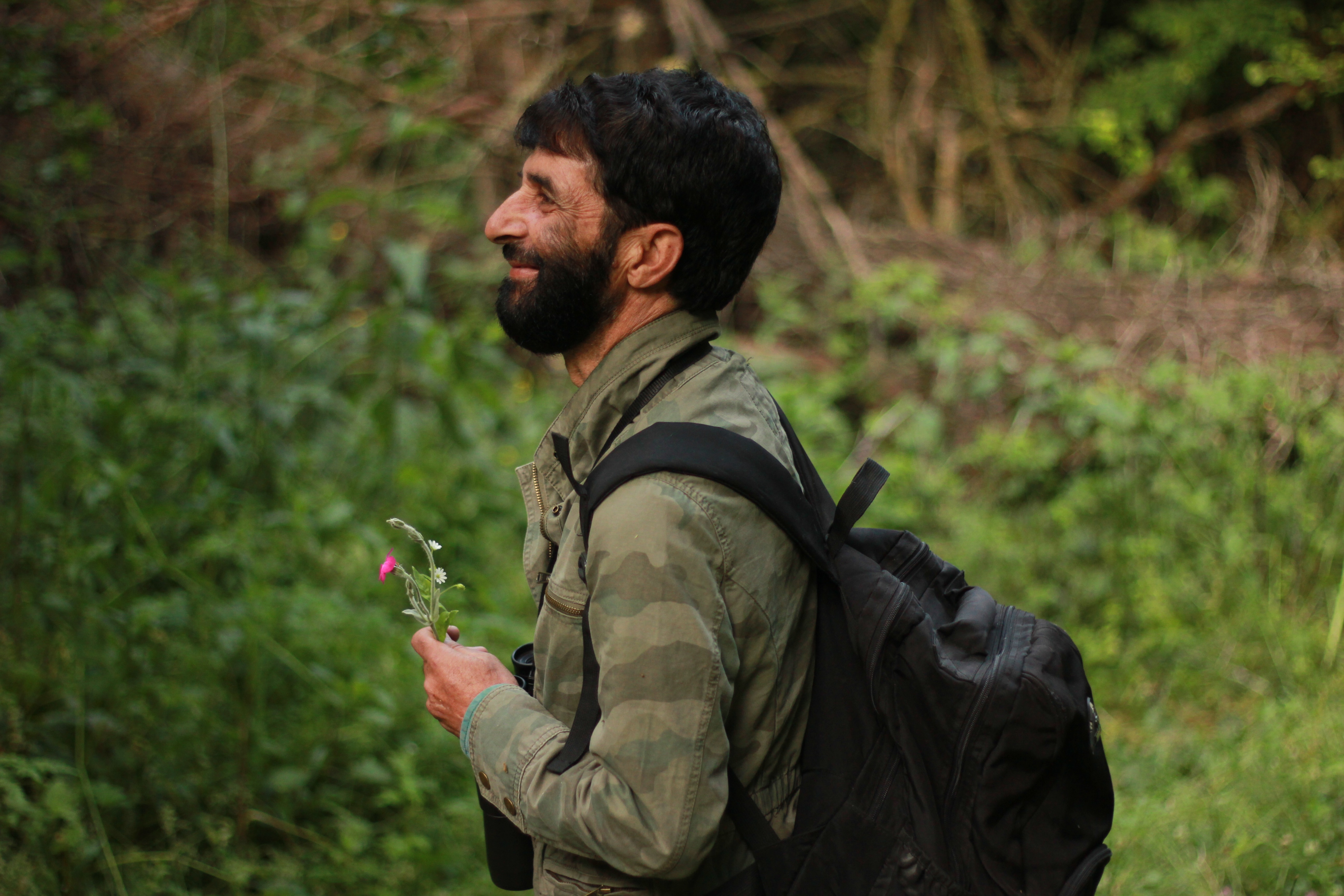
Photo courtesy: Cara Tejpal.
The People’s Forest
Young indigenous filmmaker Serlibon Timungpi elucidates on ‘The Forest Project’, an ongoing effort to involve communities in Assam’s Karbi Anglong landscape with forest regeneration.
Language: English
Sacred Heart
Grassroots conservationist Sunil Harsana* traces the history and status of Mangar Bani, a threatened sacred forest sandwiched between the suburbs of New Delhi.
Language: Hindi
Desert Herders
Ladakhi scholar and community leader Stanzin Namgail shares how his Changpa community adopted snow leopard–friendly practices for sustainable grazing. Continuing on this theme, Ladakhi elder Karma Sonam details the pioneering community initiative to convert shandongs (wolf traps) into stupas (places of worship) to both protect wolves and preserve an ancient symbol of herding communities in the region.
Language: English, Hindi
Pukhoor with Sangeethasin
Pukhoor is the unique embroidery of the Toda pastoral people of the Nilgiris that is protected by the Indian government. Toda representative Sangeethasin showcases this gorgeous handicraft and chats with the audience about her heritage.
Language: English
Forest Farmers
Community activists Vijayarani (left) and Valli (right) connect the dots between forests and agriculture. They elucidate on their work training women to monitor natural resources and adopt organic farming practices, while sharing nuggets of traditional wisdom from their Irula community.
Language: Tamil, with an English interpreter
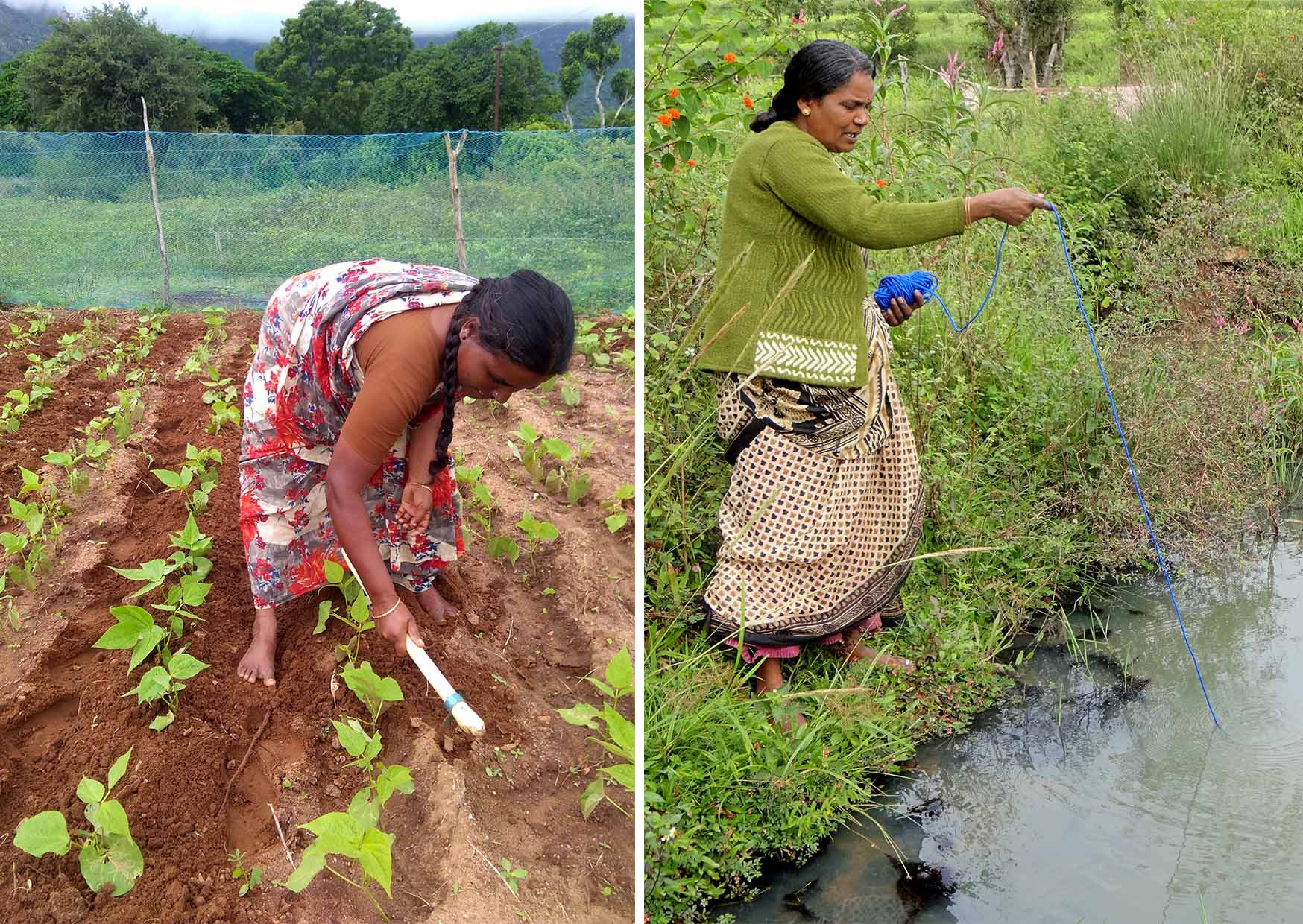
Photo courtesy: Keystone foundation
Valley of Cranes
Through film clips and anecdotes, firebrand conservationists Komo Dechin and Pemba Romo take us on a journey to the Zemithang Valley to meet two iconic but neglected species – the red panda and the Black-necked Crane.
Language: English & Hindi
Against the Odds
Still notorious for their animal tracking and hunting skills, the Pardhi community has been subject to exploitation and discrimination since the time of the British Raj. Young Neelam Baheliya speaks about shattering stereotypes, challenging archaic cultural norms and chasing her dreams.
Language: Hindi
Baagh Baithak, Tiger Talk
Gather around, sit down and listen up! Nandu Singh has been tracking tigers in the Palamau Tiger Reserve for over 30 years. In an informal chat with natural historian Raza Kazmi, he regales us with stories from the field.
Language: Hindi and English
Secrets of Sindhudurg
Grassroots wildlife conservationist Malhar Indulkar* is putting Kanhalachi Rai, a sacred Myristica swamp, on the map. He speaks on community conservation efforts and otter presence in and around this special swamp.
Language: Hindi and English
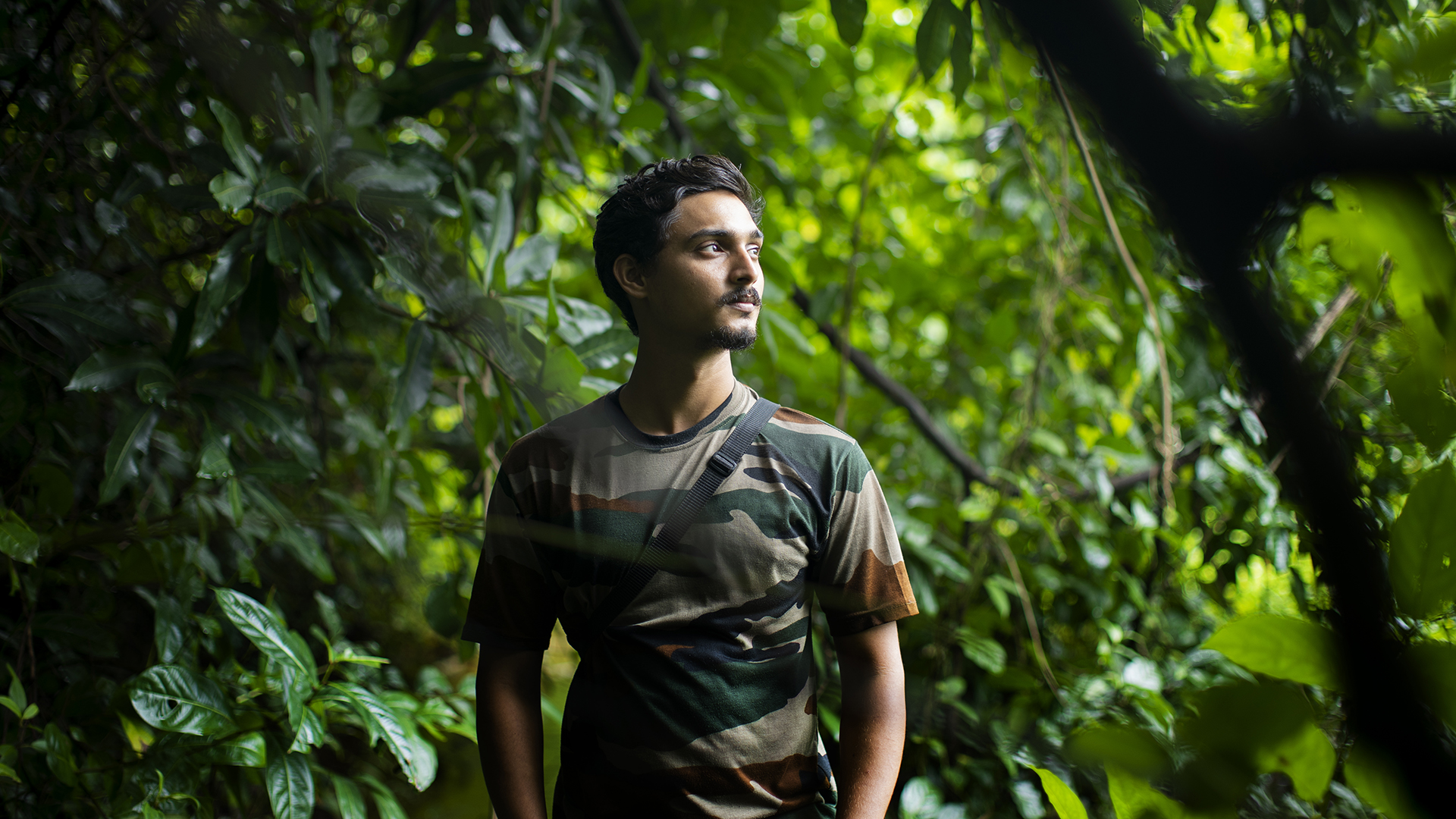
Photo courtesy: Malhar Indulkar
Between Sanctuaries
Grassroots conservationist Bhuvaneshwara H.S.* tells us how he deploys diverse skills for the protection of four umbrella species – Nilgiri martens, Malabar Pied Hornbills, lion-tailed macaques, and small-clawed otters – in an unprotected landscape in Karnataka.
Language: Kannada, with an English Interpreter
Mahila Shakti
Eliza Boro, Founder of the Mahila Shakti Kendra in Assam, speaks about her efforts to mobilise rural women in Sonitpur district to form Self Help Groups, earn independent incomes, and support habitat restoration efforts led by the Bali para Foundation.
Language: Hindi and English
Land of Plenty
In the foothills of Assam, one man is preserving indigenous varieties of rice through his unique Annapurna Seed Library. Mahan Chandra Borah traces the origins of his library, showcases the seeds he preserves, and shares why this is key to building climate resilience.
Language: English
Citizen Patrol
A dedicated team of community volunteers is bringing down crime in Karnataka’s Cauvery Wildlife Sanctuary. Team leader Ashwin Gurusrikar* shares the trials, tribulations and triumphs of providing ground support to the state Forest department.
Language: English
Lost in Lahaul
Though it doesn’t boast a single Protected Area, the Lahaul Forest Division in Himachal Pradesh is home to snow leopards, Himalayan brown bears and more. Forest guard Shiv Kumar* showcases the biodiversity of the stark wilderness that he protects.
Language: English and Hindi
Woman. Viper. Venom.
Two years ago, Marina Juliet* had never touched a snake. Today, she works on the world’s first Russell’s viper radio telemetry project. She narrates her experiences Withconflict mitigation, data collection, animal care, and education.
Language: Kannada, with an English interpreter
When the Elephants Came
Grassroots activist Sajal Madhu* takes us into the interiors of the Indian state of Chhattisgarh where human-elephant conflict is on the boil, but solutions remain elusive and the state remains impassive.
Language: Hindi, with an English interpreter
Rotten Fruit
As forest guards in Mizoram’s Dampa Tiger Reserve, Zakhuma Don* and Lavohbika Hrahsel tackle conservation issues on the daily. In this illustrated talk, they reckon with a new and powerful enemy that threatens to wreak havoc in the
state – oil palm.
Language: Hindi, with an English interpreter
A Smoking Gun
From pangolins to clouded leopards – for years, the best place for a visitor to appreciate the diversity of wildlife found in Manipur was the local markets, where hunters brought their quarry. Naturalist Mordecai Panmei narrates the story of The Rainforest Club, Tamenglong, a volunteer collective that is challenging hunting culture.
Language: English
The Chroniclers
National Geographic Explorer Ram Alluri and indigenous filmmaker Lepo Mello have been documenting traditional knowledge and stories from communities in the remote Dibang Valley. They offer us a taste of what they have collected thus far.
Language: English, Hindi
The Pied Piper of Sawai Madhopur
Gentle, soft-spoken Govardhan Meena drives his trusty Tiger Express van from village to village on the fringes of the Ranthambhore Tiger Reserve. He shares the blueprint for his successful community engagement initiative.
Language: Hindi, with an English interpreter
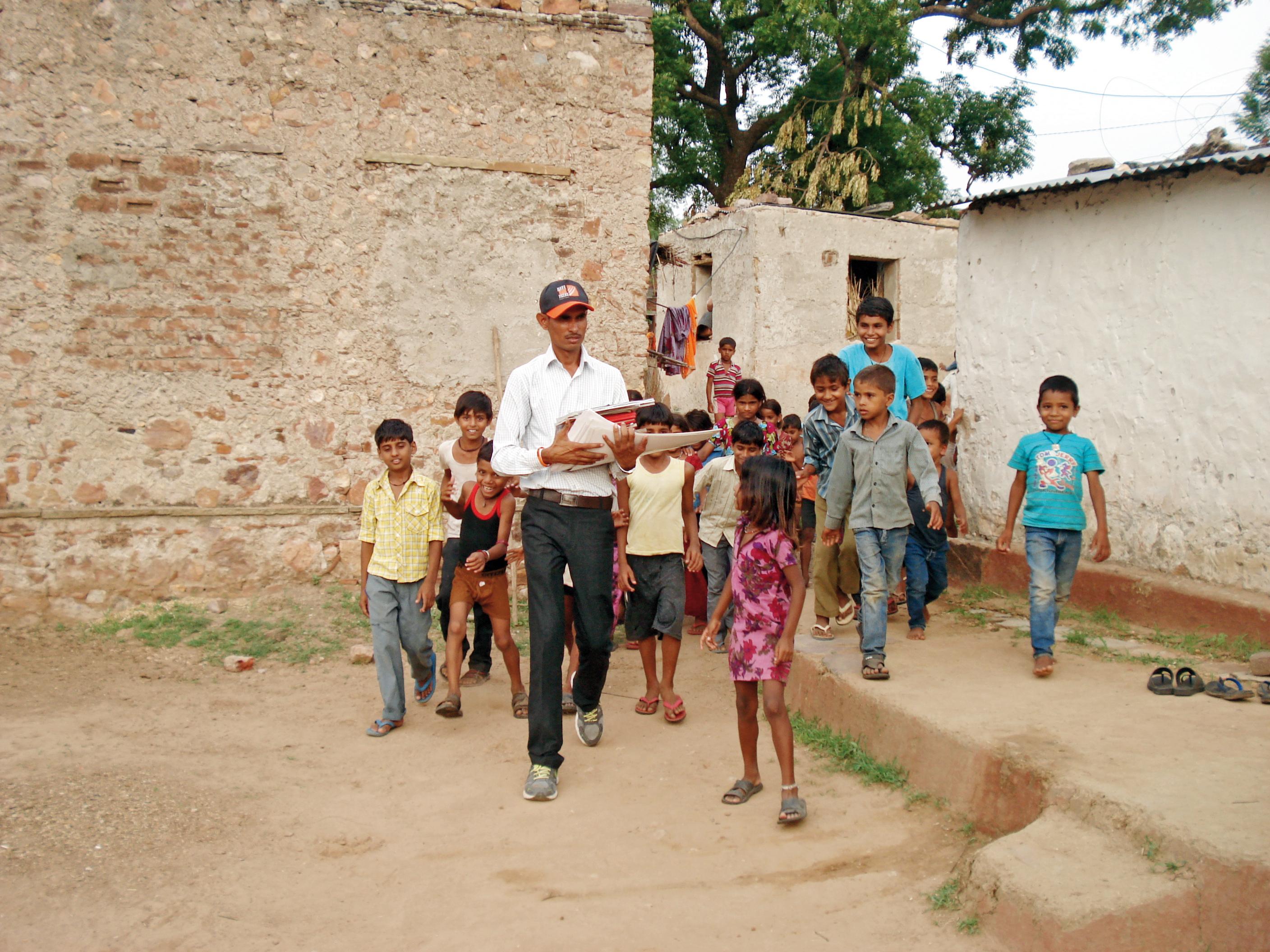
Photo courtesy: Govardhan Meena.
* These individuals have received support from the Mud on Boots Project for their work. To contact any of the speakers mentioned, feel free to write to cara@sanctuaryasia.com.
Cara Tejpal leads conservation initiatives for Sanctuary Nature Foundation and is a commissioning editor for Sanctuary Asia magazine.







_1606973131.jpeg)



